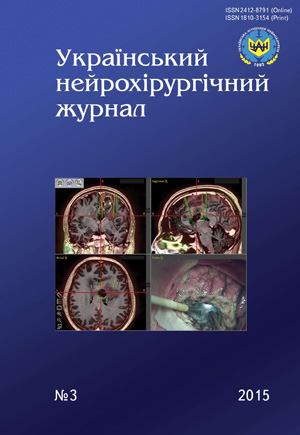Features of clinics and therapy of secondary meningoencephalitis in traumatic brain injury
DOI:
https://doi.org/10.25305/unj.50116Keywords:
traumatic brain injury, secondary meningoencephalitis, pyoinflammatory complications, antibacterial therapy, intrathecal therapy, liquorrheaAbstract
Objective. To increase efficacy of treatment of patients with secondary meningoencephalitis (SME) during intermediate period of traumatic brain injury (TBI) by including intratecal methods into complex of intensive care.
Materials and methods. It is shown the results of examination and treatment of 23 patients with SME within intermediate period of TBI. Manifestations of SME were kept more than 2 months in the most of patients despite on intensive therapy they had received within acute period, which definitely increased patients’ condition after TBI, complicated prognosis for live and recover.
Results. Predictors for prolonged, palindromic course of SME for this patients were: nasty TBI, liquorrhea, resistance of microflora to used antibacterial medicines, development of other intracranial complications such as abscess, hidrocephaly, ventriculitis. It is demonstrated a necessity of timely updating of traditional systemic antibacterial therapy by intrathecal one to efective sanation of liquor, correction of liquor pressure and dynamic monitoring of liquorologic indices.
Conclusions. Recommended tactic of treatment allowed receive durable positive clinical and liquorological effect in 73.9% of patients even on second week of therapy. It was diagnosed virus-bacerial mixt-infection in 17.4% of incidences for patients with SME due to reactivation of herpesviruses, which is necessary to take into account for diagnostic and treatment of SME.
References
1. Konovalov AN, Lihterman LB, Potapov AA, editors. Cherepno-mozgovaya travma [Traumatic Brain Injury]. Moscow: Antidor; 1998. Russian.
2. Gean AD, Fischbein NJ. Head trauma. Neuroimag Clin N Am. 2010;20(4):527-556. [CrossRef] [PubMed]
3. Heegaard W, Biros M. Traumatic brain injury. Emerg Med Clin N Am. 2007;25(3):655-678. [CrossRef] [PubMed]
4. Belyakov KV. Infektsionnyye oslozhneniya ognestrel'nykh cherepno-mozgovykh raneniy [Infectious complications of gunshot craniocerebral wounds] [dissertation]. St. Petersburg (Russia): Kirov Military Medical Academy; 2008. Russian.
5. Gorbunov VI. [Pathogenesis ot intracranial purulent complications in grave craniocerebral injury]. Neurohirurgia. 1998;(2):22-25. [eLIBRARY]
6. Stavitsky DM. Narusheniye proteoliticheskikh protsessov v likvore patsiyentov s ushibami golovnogo mozga razlichnoy stepeni tyazhesti i metody ikh korrektsii [Disorders of proteolytic processes in cerebrospinal fluid of patients with brain injuries of different severity and methods of their correction] [dissertation]. Novosibirsk (Russia): Novosibirsk Institute of Traumatology and Orthopedics; 2005. Russian.
7. Voevodin SV. Kliniko-prognosticheskaya znachimost' belkov ostroy fazy pri infektsionnykh oslozhneniyakh tyazheloy cherepno-mozgovoy travmy [Clinical and prognostic significance of acute phase proteins in infectious complications of severe traumatic brain injury] [dissertation]. Kemerovo (Russia): Kemerovo Medical Academy; 2006. Russian.
8. Kan SL. Osobennosti pronitsayemosti gematoentsefalicheskogo bar'yera pri kriticheskikh sostoyaniyakh, obuslovlennykh tyazheloy cherepno-mozgovoy travmoy u shakhterov [Features of the blood brain barrier permeability in critical conditions due to severe traumatic brain injury in miners] [dissertation]. Moscow (Russia): Burdenko Institute of Neurosurgery; 2006. Russian.
9. Litman AB. Kliniko-immunologicheskiye osobennosti sochetannoy cherepno-mozgovoy travmy, printsipy diagnostiki i lecheniye yeye oslozhneniy gerpeticheskoy etiologii [Clinical and immunological features of combined traumatic brain injury, principles of diagnosis and treatment of its complications of herpetic etiology] [dissertation]. St. Petersburg (Russia): Russian Research Polenov Neurosurgical Institute; 2008. Russsian.
10. Muhametzhanov H. Patologiya likvornoy sistemy pri cherepno-mozgovoy travme [The pathology of the liquor system in traumatic brain injury] [dissertation]. Moscow (Russia): Burdenko Institute of Neurosurgery; 2002. Russian.
11. Davydov RS. Optimizatsiya lecheniya i taktiko-tekhnologicheskikh priyemov pri khirurgicheskom lechenii nazal'noy likvorei [Optimization of treatment and tactical-technological methods in surgical treatment of nasal liquorrhea] [dissertation]. St. Peterburg (Russia): Saint-Petersburg Research Institute of Ear, Throat, Nose and Speech; 2009. Russian.
Downloads
Published
How to Cite
Issue
Section
License
Copyright (c) 2015 Elena Panasyuk, Sergiy Borshchov, Victor Matiash, Vladimir Trikhleb, Daria Govorova

This work is licensed under a Creative Commons Attribution 4.0 International License.
Ukrainian Neurosurgical Journal abides by the CREATIVE COMMONS copyright rights and permissions for open access journals.
Authors, who are published in this Journal, agree to the following conditions:
1. The authors reserve the right to authorship of the work and pass the first publication right of this work to the Journal under the terms of Creative Commons Attribution License, which allows others to freely distribute the published research with the obligatory reference to the authors of the original work and the first publication of the work in this Journal.
2. The authors have the right to conclude separate supplement agreements that relate to non-exclusive work distribution in the form of which it has been published by the Journal (for example, to upload the work to the online storage of the Journal or publish it as part of a monograph), provided that the reference to the first publication of the work in this Journal is included.









